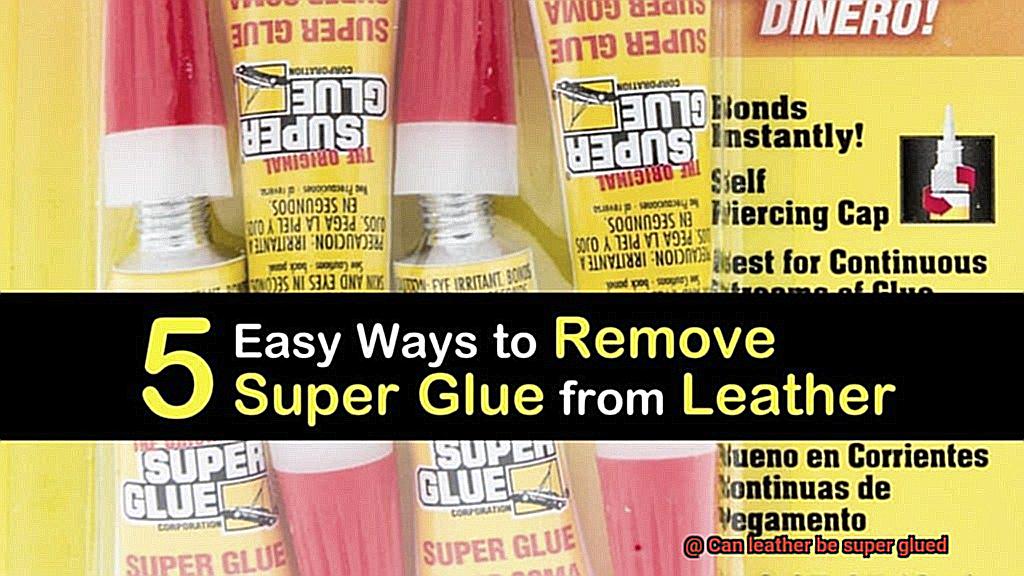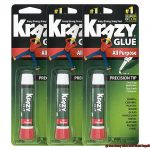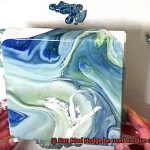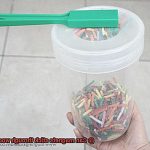Got a well-worn leather handbag or a pair of shoes on the verge of retirement? Don’t despair, my fellow leather enthusiasts. Today, we’re diving headfirst into the world of leather repair, armed with an unexpected secret weapon: super glue.
Before you scoff at the idea and dismiss it as sheer lunacy, let’s dig deeper into this process and uncover any potential risks. Can leather really be super glued? Will it stand the test of time or make matters worse? Buckle up, because we’re about to embark on a wild ride through the sticky intricacies of using super glue to revive your beloved leather goods.
Now, let me be clear – not all leather repairs can be salvaged with super glue. There are risks involved, so proceed with caution. Test in hidden spots first before committing to any repairs. But fear not. With expert knowledge and our shared passion for all things leather, we’ll navigate through the do’s and don’ts together.
Disclaimer: While this method may seem tempting, it’s crucial to remember that not all leather repairs can be fixed with super glue. There are potential risks involved. So tread carefully and always test inconspicuously before attempting any repairs. Now, let’s unveil this fascinating technique and explore its wonders.
Preparing the Leather Surface for Adhesion
Contents
- 1 Preparing the Leather Surface for Adhesion
- 2 Applying Super Glue to Leather
- 3 Holding the Pieces Together and Allowing Time to Dry
- 4 Avoiding Stress on the Bonded Area Immediately After Application
- 5 Testing a Small Area Before Proceeding with Larger Surfaces
- 6 Removing Super Glue from Unwanted Areas of Leather
- 7 Safety Precautions When Using Super Glue
- 8 Different Types of Leather and Their Suitability for Super Glue Adhesion
- 9 Conclusion
When it comes to repairing or bonding leather, super glue can be a lifesaver. But before you reach for that bottle of cyanoacrylate adhesive, it’s essential to prepare the leather surface properly to ensure successful adhesion. Here’s how to get your leather ready for super glue:
- Clean the leather: Begin by giving the leather surface a thorough cleaning using a mild soap or leather cleaner. Use a soft cloth or sponge to gently remove any dirt, dust, or oils that may be lurking on the surface. Harsh chemicals and abrasive materials should be avoided to prevent damage to the leather.
- Sand the surface: Depending on the condition of the leather, a light sanding can improve adhesion. Grab some fine-grit sandpaper and gently rub it in circular motions over the leather. Remember not to apply too much pressure or sand too aggressively, as this could harm the leather.
- Remove finishes: If your leather has any varnish, paint, or other coatings, it’s crucial to strip them away before applying super glue. These finishes can create a barrier that hinders proper adhesion. Use a leather deglazer or acetone and rub a small amount onto a cloth, then gently remove the coatings from the surface.
- Condition the leather: After cleaning and sanding, it’s time to give your leather some TLC with a conditioning treatment. Leather conditioners restore moisture and flexibility, making the material more receptive to adhesives. Take a small amount of conditioner on a soft cloth and massage it into the leather in circular motions. Let it absorb for a few minutes before wiping off any excess with a clean cloth.
- Test on a small area: Before going all out with the super glue, perform a patch test on an inconspicuous area of the leather. Apply a small amount of adhesive and let it cure as per the manufacturer’s instructions. Check for any discoloration, changes in texture, or weakening of the leather. If there are no adverse effects, you can proceed with applying the adhesive to the rest of the leather.
Once you’ve prepared the leather surface, it’s time to apply the super glue. Use a small amount and spread it evenly over the area that needs bonding. Be cautious not to use excessive amounts, as this can cause unsightly stains if the glue seeps through the leather.
After applying the super glue, firmly hold the pieces together for a few minutes to allow the adhesive to dry and bond properly. The drying time may vary depending on the brand and type of super glue you’re using.
It’s worth noting that not all types of leather are suitable for super glue adhesion. It’s always wise to test a small, inconspicuous area before proceeding with larger surfaces to avoid any potential discoloration or damage.
Applying Super Glue to Leather
Leather, a material that exudes luxury and durability, deserves only the best when it comes to repairs or bonding. Enter super glue, also known as cyanoacrylate adhesive, a handy solution for leather applications. However, applying super glue to leather requires finesse and precaution for a successful outcome. In this comprehensive guide, we will cover the steps and tips you need to master the art of applying super glue to leather.
Step 1: Prepare the surface:
Begin by ensuring your leather surface is clean and free from dirt or oils that can hinder adhesion. Gently wipe it down with a clean cloth or use a specialized leather cleaner for optimal results. This step is crucial for ensuring a strong bond and preventing any unwanted reactions.
Step 2: Test it out:
To avoid potential mishaps or damage to your precious leather item, always perform a patch test in an inconspicuous area. Apply a small amount of super glue and observe any adverse reactions or discoloration. It’s better to be safe than sorry.
Step 3: Apply with precision:
With the surface prepped and the glue tested, it’s time for the main event. Apply a minimal amount of super glue to one of the surfaces that require bonding. Remember, less is more. Press the two surfaces together firmly and hold them in place for a few moments to let the glue work its magic.
Step 4: Handle with care:
Excessive application of super glue can seep through the leather, leaving unsightly marks or stains. Moreover, using too much glue may result in a stiff and uncomfortable texture. Exercise caution and apply just enough glue for a secure bond. A little goes a long way.
Step 5: Clean up spills:
Oops. If any excess glue spills onto the leather surface, don’t panic. Grab a clean cloth or cotton swab and dampen it with acetone or nail polish remover. Gently wipe off the excess glue, taking care not to rub too vigorously. However, be mindful as these solvents may cause discoloration or damage to the leather. Proceed with caution and precision.
Step 6: Patience is key:
After applying super glue to leather, resist the temptation to use or handle the item immediately. Allow ample time for the glue to dry completely. The drying time may vary depending on the brand and type of super glue used. Exercise patience and let the glue work its magic undisturbed.
Step 7: Consult an expert:
While super glue can work wonders for certain leather repairs, it may not be suitable for all types and finishes of leather. When dealing with valuable or delicate leather items, it is always wise to seek advice from a professional or leather repair expert. They can guide you towards specialized leather adhesives designed for optimal results.
Holding the Pieces Together and Allowing Time to Dry
Leather, a material that exudes versatility and luxury, demands special care when it comes to bonding. Whether you’re repairing a torn leather jacket or fashioning a captivating leather craft, achieving a flawless bond requires more than just slathering on some glue.
In this comprehensive guide, we will delve into the intricacies of holding the pieces together and allowing ample time for the glue to dry. So, let’s embark on this journey of precision and patience.
Proper Alignment for Unbreakable Bonds:
Before the adhesive even touches the surface, ensuring impeccable alignment of the leather pieces is paramount. The strength of the bond directly correlates with the precision of alignment. Dedicate time to meticulously position the pieces, ensuring a seamless fit. Your attention to detail will undoubtedly reap rewards in the long run.
Mastering Holding Methods:
As you venture into the drying process, various methods can firmly hold those leather pieces in place. Clamps, renowned for their efficacy, take center stage. However, exercise caution when employing them. Adjust them with utmost care, exerting enough pressure to keep the pieces together securely without inflicting any harm. Should clamps prove unsuitable or unavailable, fear not. Rubber bands, clothespins, or even weighty objects can come to your rescue. Harness their power and gently apply pressure to the glued area.
The Virtue of Patience:
With the leather pieces securely held in place, it’s time to embrace patience—a virtue that yields wondrous results. The super glue requires ample time to dry thoroughly and forge an unyielding bond. Remember that drying times may vary depending on factors such as glue type, temperature, and humidity levels. If uncertainty lingers like a shadow, consult the product instructions or seek guidance from seasoned professionals who possess profound wisdom on drying times.
Disturbance Detriment:
During the drying process, resist any temptation to disturb or jostle the leather pieces. Every ounce of stress or pressure applied during this critical phase has the potential to weaken or shatter the bond you’ve painstakingly crafted. Suppress your curiosity and grant the super glue the undisturbed space it needs to weave its magic.
Leather’s Porous Nature:
Bear in mind that leather, with its porous nature, absorbs some of the adhesive. Consequently, it may take longer to dry compared to other materials. Embrace patience wholeheartedly and allow sufficient time for the bond to solidify flawlessly. Your unwavering commitment will be rewarded with a bond that stands the test of time.
Avoiding Stress on the Bonded Area Immediately After Application
You’ve just applied super glue to bond your leather project together, and now you’re wondering how to avoid putting stress on the bonded area. Well, fear not. We have some valuable tips to help you ensure a strong and long-lasting bond without compromising the integrity of your leather masterpiece.
First and foremost, give it time. Patience is key when working with delicate materials like leather. Allow the glue ample time to dry and set, following the manufacturer’s instructions for the best results.
Depending on the brand and type of super glue you’re using, drying times can vary. Generally, most super glues require a few minutes to reach their maximum bonding strength.
While the glue is drying, keep it stable. Treat your leather creation like royalty during this crucial period. Avoid any movements or manipulations that could put pressure on the glued area.
If possible, lay the leather flat and undisturbed until the glue has fully cured. This will ensure a strong bond without compromising the structural integrity of the leather.
Even after the glue has dried completely, handle with care. Remember, leather is a delicate material, and excessive stress or strain can weaken even the strongest bonds over time. So be mindful of how you handle and use your leather project to maintain its longevity and appearance.
Testing a Small Area Before Proceeding with Larger Surfaces
Today, I want to emphasize the importance of a crucial step that often gets overlooked when it comes to gluing leather surfaces – testing a small area before diving into the larger project. Trust me, this simple precaution can save you from potential disasters and ensure that your leather projects look absolutely top-notch.
Why is it so important to take this extra step? Well, let’s face it – leather is a diverse material with different types reacting differently to super glue. The last thing you want is discolored or damaged leather, right? That’s why a small test can make all the difference.
Here’s how you do it. Grab a small piece of scrap leather or find an inconspicuous spot on the leather item you plan to glue. Apply just a tiny amount of super glue to the area and let it dry completely. Take a close look and observe any changes in texture, color, or overall appearance. If everything looks good, you’re good to go with gluing the larger surfaces.
But wait. Even if the small area test seems promising, exercise caution when applying super glue to larger areas of leather. Leather can vary in quality and composition, meaning what worked for one piece may not work for another. It’s always better to err on the side of caution, don’t you agree?
Now, here’s an important note – super glue isn’t always the best adhesive choice for every type of leather project. Delicate or soft leathers like suede or lambskin may not appreciate being bonded with super glue. It could cause damage or leave unsightly marks. In these cases, it’s wise to explore alternative adhesives specifically designed for bonding leather.

Let me tell you, there are some pretty fantastic specialized leather glues out there. These babies offer better flexibility and compatibility with different types of leather.
So, if you’re working with a delicate leather, don’t be afraid to give those alternatives a try.
Remember, my fellow crafters, always read and follow the instructions provided by the manufacturer of both the super glue and any alternative adhesive you choose to use. Proper application techniques and curing times are key to achieving a strong and durable bond without compromising your precious leather.
In conclusion, testing a small area before applying super glue to larger surfaces of leather is an absolute must. It helps you ensure compatibility, avoid potential damage or discoloration, and keep your leather projects looking their best.
Removing Super Glue from Unwanted Areas of Leather
I possess the knowledge to liberate your leather from this adhesive menace. Prepare to be amazed as I divulge tried and tested methods that will eradicate stubborn super glue stains without inflicting harm upon your beloved leather.
First and foremost, it is imperative to test any removal method on a small, inconspicuous area of the leather. This precautionary measure ensures that you do not exacerbate the problem at hand.
One highly effective technique involves the use of acetone, which can be found in its pure form or in nail polish removers. It is crucial to select pure acetone rather than a remover infused with detrimental ingredients. Take a clean cloth or cotton swab and apply a small amount of acetone. Gently dab at the glue and allow it to soften for a few minutes before delicately peeling it off with a fingernail or plastic scraper. Repeat this process as necessary until every trace of glue has vanished.
Another formidable option is rubbing alcohol. Simply apply a small amount to a cloth or cotton swab, dab at the glue, and grant it a few minutes to work its magic before gingerly peeling it off. This method operates similarly to acetone but may be more readily accessible within your household.
Should acetone or rubbing alcohol be absent from your arsenal, fret not. Warm soapy water and a soft cloth shall come to your aid. Create a mixture of mild soap and warm water, dampen the cloth, and gently dab at the glue. Take care not to oversaturate the leather. Allow the soapy water to rest for several minutes before carefully peeling off the glue.
Throughout these methods, remember that patience and gentleness are of paramount importance. Avoid using sharp instruments or exerting excessive force to prevent any damage from befalling your precious leather. Once the super glue has been successfully expelled, cleanse the area with a mild leather cleaner or saddle soap to eliminate any remnants from the removal process. Conclude this triumphant endeavor by applying a leather conditioner to revive moisture and uphold the leather’s supple nature.
However, what if the super glue has deeply penetrated the leather or the aforementioned methods have proven fruitless? In such dire circumstances, it is advisable to seek professional assistance from a leather specialist or a professional cleaner with expertise in handling stubborn super glue situations.
Safety Precautions When Using Super Glue
Super glue is a powerful adhesive that can bond surfaces together quickly and effectively. However, it is important to use super glue safely to avoid any accidents or injuries. Here are some safety precautions to consider when using super glue:
- Work in a well-ventilated area: Super glue releases fumes that can be harmful if inhaled in large quantities. It is important to work in a well-ventilated area, such as an open room or with a fan running, to minimize the inhalation of these fumes.
- Protect your eyes: Super glue can easily splash or drip into your eyes, causing irritation or potential damage. Always wear protective eyewear, such as safety goggles or glasses, to shield your eyes from any accidental contact with the glue.
- Protect your skin: Super glue bonds quickly and can adhere to the skin almost immediately upon contact. To avoid accidental skin bonding, it is important to protect your hands and other exposed skin areas. Consider wearing gloves or using barrier creams before handling super glue. If super glue does come into contact with your skin, do not panic. Soak the affected area in warm soapy water and gently separate the bonded surfaces using a blunt object.
- Wear appropriate clothing: Super glue can easily stick to fabric and ruin clothing. To prevent this, wear old or protective clothing when working with super glue. Additionally, keep a cloth or towel nearby to immediately wipe off any accidental spills or drips on clothing.
- Avoid ingestion: Super glue is not intended for consumption and should never be ingested. Keep super glue containers safely out of reach of children and pets to prevent accidental ingestion. In case of ingestion, seek immediate medical attention and provide the necessary information about the ingested substance.
- Store properly: Proper storage of super glue is important for maintaining its quality and preventing accidents. Store super glue containers in a cool, dry place away from direct sunlight and heat sources. Ensure they are tightly sealed to prevent any leakage.
- Have a first aid kit nearby: Despite taking precautions, accidents can still occur when using super glue. It is important to be prepared with a basic first aid kit nearby. In the event of accidental skin bonding, seek medical advice if necessary. If the glue comes into contact with the eyes, rinse them with water for at least 15 minutes and seek immediate medical attention.

Different Types of Leather and Their Suitability for Super Glue Adhesion
Leather is a versatile and durable material that has been used for centuries to create various products, including jackets, shoes, and furniture. However, when it comes to repairing or bonding leather items, the question arises: can super glue be used? The suitability of different types of leather for super glue adhesion varies. Let’s explore the five main types of leather and their compatibility with super glue.
Genuine Leather: The Super Glue Hero
Genuine leather, made from the hides of animals like cows, is renowned for its strength and durability. When it comes to super glue adhesion, genuine leather is the hero. Its porous nature allows the glue to penetrate the material, creating a robust bond. However, it’s important to note that different types of genuine leather, such as full-grain or top-grain, may have varying levels of bonding success. Therefore, it’s crucial to choose the right type of genuine leather for optimal results.
Bonded Leather: The Sneaky Adhesive Enemy
Bonded leather may deceive you with its resemblance to genuine leather, but it’s actually a blend of genuine leather scraps and synthetic materials. Unfortunately, these synthetic components can play tricks on super glue, making it more challenging for them to stick together. Additionally, bonded leather often has a protective coating that further hampers super glue adhesion. In such cases, alternative bonding methods or specialized adhesives may be needed.
Nubuck Leather: The Tricky Texture
Nubuck leather is like suede’s sophisticated cousin with a finer grain and a tougher finish. However, when it comes to super glue adhesion, nubuck leather can be a bit tricky. Its delicate texture and fine grain make it less porous compared to other types of leather.
As a result, the glue may not absorb as effectively, resulting in a weaker bond. While super glue can still be used on nubuck leather, it may not provide the same strength or longevity as with other leathers.
Suede Leather: A Sticky Situation
Suede leather is renowned for its softness and fuzzy texture, making it ideal for cozy jackets and stylish shoes. However, when it comes to super glue, suede can present a sticky situation. Its rough texture and lack of a smooth surface make it more challenging for the glue to create a strong bond.
The glue may struggle to penetrate the material effectively, leading to weaker adhesion. It’s recommended to explore alternative methods like stitching or specialized suede adhesives for bonding suede leather.
Exotic Leather: The Super Glue Challenge
Exotic leathers, such as snakeskin or alligator, boast unique patterns and textures that make them stand out. However, their distinctive properties can pose a challenge for super glue adhesion. The scales, ridges, or uneven surfaces of exotic leathers make it difficult for the glue to adhere properly.
In such cases, consulting a professional or using specialized adhesives designed specifically for bonding exotic leathers is advisable.
Conclusion
In conclusion, the answer to the question “Can leather be super glued” is a resounding yes.
Leather can indeed be effectively bonded using super glue. The powerful adhesive properties of super glue make it suitable for joining leather pieces together or repairing torn leather items.
Its quick-drying nature ensures that your repairs are completed in no time, allowing you to get back to enjoying your beloved leather items.






